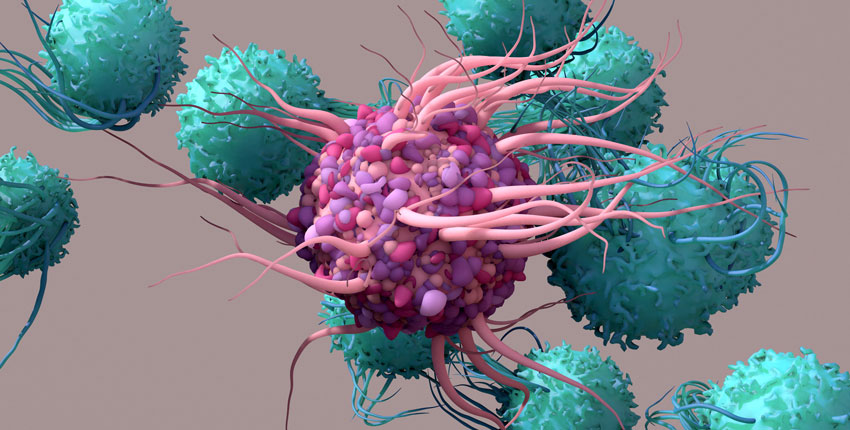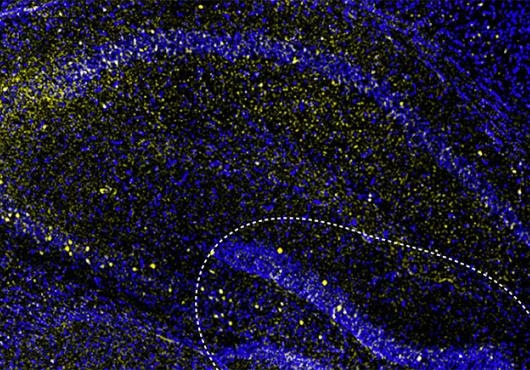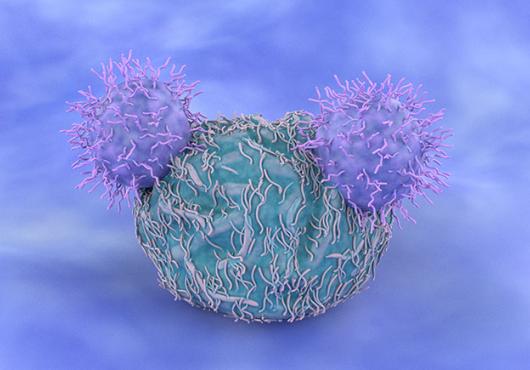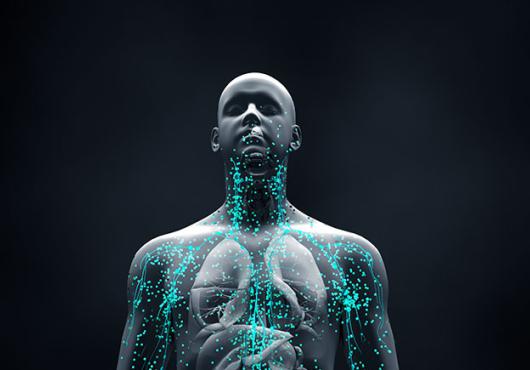
This article is part of Harvard Medical School’s continuing coverage of COVID-19.
Since the start of the COVID-19 pandemic, antibodies have dominated the attention of both physician-scientists and the public. They have been the object of intense research across scientific labs. They formed the basis of SARS-CoV-2 vaccines and antibody-based therapies, acquiring household-name status in the process.
This fame is well-deserved.
Churned out by the immune system when it encounters a pathogen, or made in response to vaccines that mimic one, these tiny proteins glom onto SARS-CoV-2 to gum up its cell-entry machinery, preventing the virus from invading cells and turning them into virus-making factories that cause widespread infection. Vaccines designed to elicit antibodies against SARS-CoV-2 are a feat of modern science and remain the most critical tool in taming the contagion.
If antibodies are the rampart around the castle, then T cells are the elite guards inside it that disable intruders should they manage to sneak in.
But for all their virtues, antibodies may have overshadowed another part of the immune system that has played a critical role in shielding us from the worst ravages of COVID-19: T cells. When antibodies fail to stop the virus from getting into our cells, T cells come to the rescue. They kill virus-infected cells, limiting the spread of the disease and halting tissue damage. If antibodies are the rampart around the castle, then T cells are the elite guards inside it that disable intruders should they manage to sneak in. In people who do get infected with SARS-CoV-2, it’s T cells that are responsible for preventing severe symptoms, hospitalizations, and deaths from COVID-19.
COVID-19 vaccines excel at inducing antibody response, but studies have shown that antibodies tend to decline within several months of immunization, requiring booster doses to prod the immune system to make more of them.
T cells, on the other hand, may represent an underutilized target for vaccines, not only against SARS-CoV-2 but against myriad other infections.
“Antibodies are extremely valuable, but if we can further bolster the immune response on the T cell side, it’ll just provide further benefit and augment those good antibodies,” said Gaurav Gaiha, assistant professor of medicine at Harvard Medical School and an immunologist at the Ragon Institute of MGH, MIT and Harvard, whose lab is focused on developing T cell-based vaccines for SARS-CoV-2, HIV, and cancer.
Powerful, not infallible
It is important not to reduce antibodies to mere neutralizers of viruses, researchers point out. Their roles in immune protection are diverse. They engage in a complex interplay with other parts of the immune system to signal the presence of pathogens, they help other immune cells devour microbes and clean up microbial debris and infected cells, and they assist other parts of the immune system in forming long-term memory of previously seen pathogens, ensuring the immune system can spring into action quickly to defend against any subsequent encounters with a past invader.
Yet, antibodies are not a foolproof defense mechanism. Like any wily pathogen, SARS-CoV-2 has developed workarounds that bypass our immune defenses. Mutations—changes to parts of the virus that render it less recognizable to antibodies—are one such workaround. SARS-CoV-2 variants have sprouted multiple mutations, most of them on the spike protein—the very part of the virus that antibodies target and neutralize. Omicron—the latest, but certainly not the last, variant of concern—has some 30 such alterations on its spike alone, allowing the variant to evade antibodies better than its predecessors. Omicron’s immune evasiveness has dramatically upped the number of breakthrough infections among individuals once deemed immune, either because of vaccination or because of prior infection.
“If anything, omicron was able to beat a lot of antibodies, so leveraging this other wonderful side of our immune response on the T cell side to provide further protection against variants is something we should seriously consider as this pandemic evolves and as new pathogens emerge,” Gaiha said.
T cell tenacity
A spate of new studies, many of them not yet peer-reviewed, have brought reassuring news about the durability and reliability of T cells in response to omicron.
“We have found that T cell responses are highly cross-reactive against variants, including omicron,” said Dan Barouch, professor of medicine at HMS and Beth Israel Deaconess Medical Center and co-lead of the vaccine research working group of the HMS-led Massachusetts Consortium on Pathogen Readiness. “In contrast, antibody responses are drastically reduced against omicron, and only partially restored with boosting.”
T cells, which arise in the bone marrow as immature white blood cells and get “trained” in the thymus to become T cells, come in many forms, each highly specialized to perform different functions. Two kinds of T cells are particularly important in responding to infections. T cells called CD8, or cytotoxic T cells (literally cell-killing cells), destroy virus-infected cells in COVID-19 and other infectious diseases. Another type of T cell called CD4 works as a helper. Both CD4 and CD8 T cells recognize tiny bits of the virus—or any other pathogen—loaded on top of infected human cells. These small viral chunks act as a beacon to draw the attention of T cells.
A not yet-peer-reviewed study led by Barouch suggests that vaccines elicit reliable T cell defense against omicron. Research out of South Africa—also not peer-reviewed—shows that T cell immunity remains robust against omicron, even as the variant escapes neutralizing antibodies. Work by an Italian team of investigators also points to preserved T cell responses among vaccinated individuals against omicron.
This T cell protection also appears to be vaccine-agnostic, meaning that it is present across recipients of different vaccines as well as among individuals with prior SARS-CoV-2 infections. A 2021 study led by Barouch comparing antibody and T cell responses across recipients of Pfizer, Moderna, and Johnson & Johnson vaccines showed that antibodies tend to rise and decline fairly quickly (within six to eight months) among mRNA vaccine recipients. By contrast, antibodies never quite reached the same levels with the vector-based J & J vaccine, yet remained relatively stable over time. The study, however, also showed that T cell responses across all vaccines remained robust and that individuals who got the vector-based J & J vaccine had somewhat higher T cell levels compared with those who got mRNA vaccines (Moderna and Pfizer).
“The rapid waning of vaccine protection from antibodies has been discouraging, but the good news is that T cell responses persist across vaccines,” said Barouch, who is also the director of the Center for Virology and Vaccine Research at Beth Israel Deaconess.
The researchers say that although these findings have yet to be peer-reviewed, they are nonetheless encouraging because multiple teams converge on the same findings: Protective T cells induced by current SARS-CoV-2 vaccines recognize the omicron variant and offer considerable protection against severe disease despite the substantial reduction of neutralizing antibody response. This is the reason why vaccinated individuals—even when the virus breaks through their immune defenses—get milder infections than unvaccinated people.
The reason for this enduring response despite viral mutations is the ability of T cells to recognize the entire length of the spike protein and generate a protective effect, not just the highly specific and mutable portions targeted by neutralizing antibodies. T cells developed following natural infection can also recognize non-spike parts of the virus because the immune system has been exposed to the entire viral genome.
Indeed, from the perspective of T cells, omicron is not a variant, Barouch said, it’s a very similar pathogen to kill.
“Whether induced by vaccine or natural infection, T cells are far better able to maintain their recognition and response than antibodies,” Gaiha said.
But the obvious advantage of vaccine-induced immunity over natural immunity, Gaiha added, is that vaccines generate an immune response without any of the inherent risks of natural infection.
But SARS-CoV-2 is an ever-surprising pathogen, and even T cells may not remain forever impervious to the virus’s shapeshifting tricks. New research led by Gaiha—currently undergoing peer review—found that T cells lost half of their reactivity against omicron in one of five people with prior immunity to SARS-CoV-2. Overall, the study is still encouraging because it shows that 80 percent of people retained T-cell response even against the heavily mutated omicron. It also showed that individuals who received vaccine boosters had enhanced antibody and T cell responses against the variant. However, it is an surprising observation, Gaiha said, which may signal that T cells could eventually lose some of their ability to recognize future variants if the virus continues to mutate.
Exploiting T cells’ potential
T cell engagement was not an explicit part of the original SARS-CoV-2 vaccine design. Optimizing current and subsequent vaccines to specifically stimulate T cells by giving the immune system exposure to the non-spike proteins of the virus would offer an important hedge against COVID-19 in the face of a rapidly mutating virus that may continue to escape antibodies.
“I think T cells offer such a tremendous opportunity to enhance current vaccines, and there hasn’t been a dedicated effort towards their induction by vaccines,” Gaiha said. “In the span of two years, we’ve seen the emergence of all these variants, so augmenting vaccines to specifically engage T cells would further solidify that backstop against severe illness.”
Such vaccines would still include spike components but also non-spike components. Even if these vaccines turn out not to lead to sterilizing immunity, which would prevent the virus from infecting our cells, they would go a long way toward ensuring that an infection with SARS-CoV-2 remains minimally symptomatic, on par with the common cold.
“I think we’ve reached a point where we understand we’ll be living with this virus for a long time, but if we can make it a mild illness that doesn’t cause severe disease that may be a tenable goal,” Gaiha said.
Another important benefit of targeted T cell stimulation would be enhancing their function in older people, whose T cells tend to lose potency and diversity with age, as well as among people who are immunocompromised, or have chronic infections or cancer, conditions that can lead to T cell exhaustion.
Depending on the mode of delivery, it is feasible that some T cell-based vaccines may go beyond disease mitigation and achieve actual viral clearance to prevent infection. For example, research in animals has shown that intranasal, rather than injectable, vaccines can induce a T cell response at the nasopharynx, the site of initial infection where the virus enters the body, and achieve clearance promptly on the spot by killing off infected cells in that region, thus preventing further spread, Gaiha said.
Lessons from HIV
One way to overcome the ongoing challenge of viral mutation in SARS-C0V-2 is to design vaccines that are variant-resistant, Gaiha said. These vaccines would target stable parts of the virus—those that remain unchanged in all variants, no matter how much the virus evolves.
This approach is informed by insights from HIV, another daunting pathogen, arguably the greatest shapeshifter among viruses, whose maneuvers Gaiha has studied for years.
As a postdoc in the lab of leading HIV researcher Bruce Walker, Gaiha teamed up with Elizabeth Rossin, HMS instructor in ophthalmology at Mass Eye and Ear, to elucidate mechanisms by which some people’s immune systems are capable of suppressing and controlling the virus.
“In HIV, it is apparent that a good CD8 T cell response targeted to the mutation-resistant parts of the virus can lead to successful suppression of the virus,” Gaiha said.
This finding is the basis for ongoing efforts to design T cell-based HIV vaccines that target nonmutable parts of the virus, protein regions so critical to the virus’s own survival that they do not change.
It is those sine-qua-non regions of any pathogenic virus that researchers should be incorporating as targets of future vaccines, Gaiha said.
Gaiha and colleagues have already mapped these structurally critical regions on SARS-CoV-2 and published their work in the summer of 2020. Using network theory, they predicted which parts of SARS-CoV-2 would remain unchanged due to their integral role in the viral structure and function. The pandemic has since then affirmed the accuracy of the team’s predictions: The variants have exploded, but the very regions they predicted would not change still haven’t mutated.
“The question in front of us now,” Gaiha said, “is how can we focus the immune response specifically on those regions of SARS-CoV-2.”





